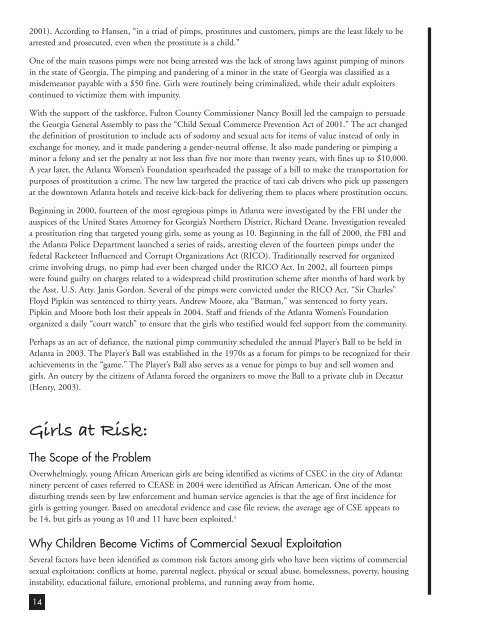atlanta_women_05_girls_0109
atlanta_women_05_girls_0109
atlanta_women_05_girls_0109
Create successful ePaper yourself
Turn your PDF publications into a flip-book with our unique Google optimized e-Paper software.
2001). According to Hansen, “in a triad of pimps, prostitutes and customers, pimps are the least likely to bearrested and prosecuted, even when the prostitute is a child.”One of the main reasons pimps were not being arrested was the lack of strong laws against pimping of minorsin the state of Georgia. The pimping and pandering of a minor in the state of Georgia was classified as amisdemeanor payable with a $50 fine. Girls were routinely being criminalized, while their adult exploiterscontinued to victimize them with impunity.With the support of the taskforce, Fulton County Commissioner Nancy Boxill led the campaign to persuadethe Georgia General Assembly to pass the “Child Sexual Commerce Prevention Act of 2001.” The act changedthe definition of prostitution to include acts of sodomy and sexual acts for items of value instead of only inexchange for money, and it made pandering a gender-neutral offense. It also made pandering or pimping aminor a felony and set the penalty at not less than five nor more than twenty years, with fines up to $10,000.A year later, the Atlanta Women’s Foundation spearheaded the passage of a bill to make the transportation forpurposes of prostitution a crime. The new law targeted the practice of taxi cab drivers who pick up passengersat the downtown Atlanta hotels and receive kick-back for delivering them to places where prostitution occurs.Beginning in 2000, fourteen of the most egregious pimps in Atlanta were investigated by the FBI under theauspices of the United States Attorney for Georgia’s Northern District, Richard Deane. Investigation revealeda prostitution ring that targeted young <strong>girls</strong>, some as young as 10. Beginning in the fall of 2000, the FBI andthe Atlanta Police Department launched a series of raids, arresting eleven of the fourteen pimps under thefederal Racketeer Influenced and Corrupt Organizations Act (RICO). Traditionally reserved for organizedcrime involving drugs, no pimp had ever been charged under the RICO Act. In 2002, all fourteen pimpswere found guilty on charges related to a widespread child prostitution scheme after months of hard work bythe Asst. U.S. Atty. Janis Gordon. Several of the pimps were convicted under the RICO Act. “Sir Charles”Floyd Pipkin was sentenced to thirty years. Andrew Moore, aka “Batman,” was sentenced to forty years.Pipkin and Moore both lost their appeals in 2004. Staff and friends of the Atlanta Women’s Foundationorganized a daily “court watch” to ensure that the <strong>girls</strong> who testified would feel support from the community.Perhaps as an act of defiance, the national pimp community scheduled the annual Player’s Ball to be held inAtlanta in 2003. The Player’s Ball was established in the 1970s as a forum for pimps to be recognized for theirachievements in the “game.” The Player’s Ball also serves as a venue for pimps to buy and sell <strong>women</strong> and<strong>girls</strong>. An outcry by the citizens of Atlanta forced the organizers to move the Ball to a private club in Decatur(Henry, 2003).Girls at Risk:The Scope of the ProblemOverwhelmingly, young African American <strong>girls</strong> are being identified as victims of CSEC in the city of Atlanta:ninety percent of cases referred to CEASE in 2004 were identified as African American. One of the mostdisturbing trends seen by law enforcement and human service agencies is that the age of first incidence for<strong>girls</strong> is getting younger. Based on anecdotal evidence and case file review, the average age of CSE appears tobe 14, but <strong>girls</strong> as young as 10 and 11 have been exploited. 3Why Children Become Victims of Commercial Sexual ExploitationSeveral factors have been identified as common risk factors among <strong>girls</strong> who have been victims of commercialsexual exploitation: conflicts at home, parental neglect, physical or sexual abuse, homelessness, poverty, housinginstability, educational failure, emotional problems, and running away from home.14


